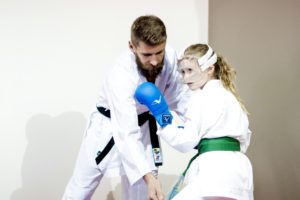
HudsonWay Immersion School : Martial arts comparison series
HudsonWay Immersion School : When choosing martial arts for children, parents often find the many different styles confusing. A question we come across is about the differences between martial arts. Another popular martial art is jiu-jitsu. Parents often wonder if this is suitable for children.
Differences between karate and jiu-jitsu
When people talk about jiu-jitsu, they are often thinking about the Brazillian style. It has roots in the original jiu-jitsu and Judo. The sport has a primary focus on ground fighting. Because of this, there is a lot of grappling in jiu-jitsu. There is a heavy emphasis on dominating an opponent, so submissions are the goal in the sport. Jiu-jitsu uses a lot of locks and chokes to be successful in competition.
In karate, students spend more time on linear movements. It is a sport where the person is more upright and uses punches and kicks. Karate promotes strength and skill to overcome an opponent. Karateka will put more emphasis on standing movements rather than the groundwork we see in jiu-jitsu.
Karate vs. jiu-jitsu – which is better?
When it comes to the best martial art, overall, it depends on what you want from the sport. A good teacher and an environment you are happy with are more important for your child. In jiu-jitsu, you will notice that students need a lot of flexibility. The sport requires a lot of contorting the body, so being very flexible is essential.
In karate, you can train with a partner or alone, whereas jiu-jitsu generally requires an opponent for practice. Jiu-jitsu is a full-contact martial art with intense grappling and forceful moves. It may not be suitable for your child. At Karate City, we teach Shotokan Karate, which is not a full-contact sport. Our lessons focus on the ethics of the sport as well as the movements and strikes. HudsonWay Immersion School
